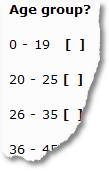
How different is a 6 year old from a 15 year old?
And how different is a 36 year old from a 45 year old?
You will probably agree with me that the difference in the first case is a lot more significant than that in the second.
So how come the 36 year old and 45 year old are likely to find themselves getting their own age brackets on many surveys (are you aged: 25 – 35?, 36 – 45?, 46 – 55? etc.) when the 6 year old and 15 year old will most likely find themelves lumped together a in the 0 – 19 bracket?
Ok. Here are some possible reasons:
.jpg) Reason #1: Relevance . We don't generally get 6 year olds to fill in surveys. And indeed, if your survey is about insurance product choice then I would suggest you're right to avoid burdening a child with questions about attitudes towards fiscal risk.
Reason #1: Relevance . We don't generally get 6 year olds to fill in surveys. And indeed, if your survey is about insurance product choice then I would suggest you're right to avoid burdening a child with questions about attitudes towards fiscal risk.
However – if you survey is about some relatively universal experience without a legal limit on who might be participating in it – like, for example, spending time in a community space, accessing the internet or feeling save (or not) crossing the road – then perhaps you should be including the 6 year old and certainly the 15 year old, in your survey.
Reason #2: Limited sample. We may suceed in surveying the 6 year old and the 15 year old, (and the 7 through 14 year olds) but we just don't manage to survey all that many of them compared to, for example, the number of 25 – 34 year olds we survey. So we put the 0 – 19 year olds together in a big category to give us a statistically significant group.
Reason #3: Skills. Carrying out a survey with children and young people can require specific skills and training that many researchers may lack.
Reason #4: Consent and ethics. There may be questions around the capacity of children and young people to give informed consent to taking part in a survey, and about whether the survey will raise questions on issues children should be protected from thinking about.
Do the reasons cut it?
Not really. Reason #1, 'Relevance', is important. It should tell us that as soon as a survey significantly covers issues that are relevant to young people they should be included in the survey data. Issues #2, 3 & 4 are ones we can and should work around.
Why does it matter?
Without including children and young people in the surveys and datasets being used by policy makers and practioners to make decisions on a day-to-day basis, we make children and young people 'statistically invisible'. And that can have a big (quite possibly very negative) impact on decisions made that affect children and young people's lives.
firstly never believe statistics 😉
Secondly I would have thought the split of age groups is entirely dependent on the subject matter. If your interest is related to young people you’re more likely to split the ‘youth’ element even further – eg. 0 – 2, 3 – 7, 8 – 10, 11 – 13 etc. or similar
If on the other hand you’re interest has little relevance to under 18’s it makes sense to block out that age group.
I can’t speak for how different a 45 year old is from a 36 year old – but I can say that my life now doesn’t compare in any way to what it was 9 years ago so I don’t think its correct to assume that people over a certain age are necessarily ‘just adults’ any more than everyone under the age of 18 is ‘just a kid’.
My third & final point – never believe statistics!
Your second point is where the issue is. We’ve got a lot of national surveys which //do// have relevance to young people – but they’re not being included to any significant extent in the surveyed sample.
It’s there that I strongly suspect statistics //are// being believed – and are having a profound impact on policy.
By means of a correction however to this post – I understand that most large scale surveys collect age in terms of Date of Birth and then convert that to an age bracket. So the key issue is in analysis not neccessarily collection (although if you know the analysis breaks down as 0 – 19 and it’s trickier to survey a 15 year old than an 18 year old, the incentive is to survey the 18 year old…)
It’s also worth pointing out there is no assumption or claim in the post above that adults are ‘just adults’.